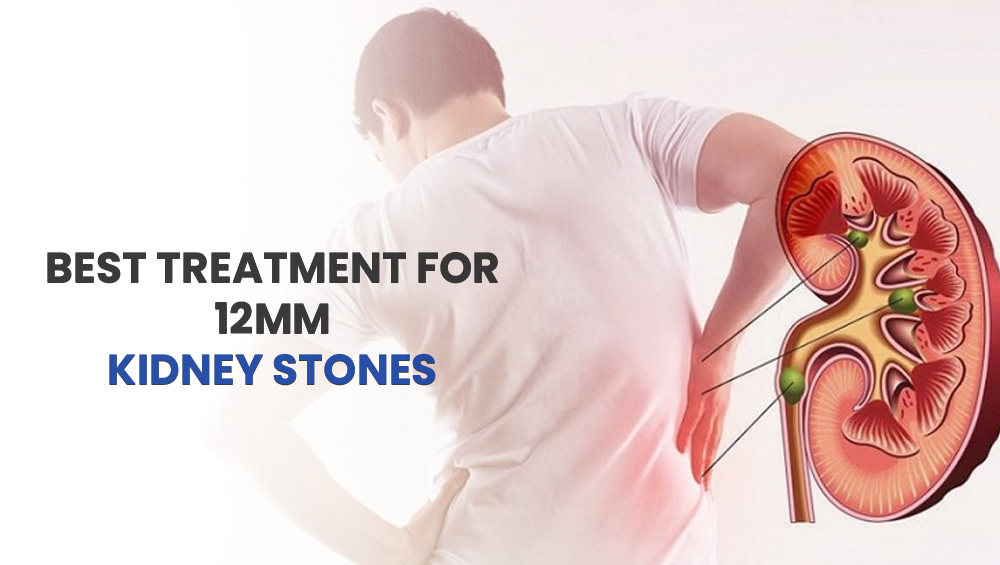Struggling with the pain and discomfort of a 12mm kidney stone can be overwhelming. You’re likely worried about the best treatment options and how to find relief quickly. Fortunately, there are highly effective treatments available that can help break down or remove the stone safely, bringing you back to comfort. In this post, we’ll explore the best treatment methods for a 12mm kidney stone, so you can take the next steps towards recovery.
How big are 12mm Kidney Stones?
A 12mm kidney stone is considered quite large when compared to the typical size of most kidney stones. To put it into perspective, a 12mm stone is roughly the size of a small marble or about half an inch. While it may seem small visually, its impact on the body can be significant.
Kidney stones form when minerals and salts in the urine crystallize and stick together. While smaller stones, typically 4-5mm, may pass naturally through the urinary tract, a 12mm stone is unlikely to do so on its own due to its size. Stones this large can cause a blockage in the ureter (the tube connecting the kidney to the bladder), which often leads to intense pain, known as renal colic, and other symptoms such as nausea, vomiting, and blood in the urine.
Complications in 12mm Kidney Stones
A 12mm kidney stone can lead to various complications, primarily due to its size and the difficulty it poses in passing through the urinary tract. If left untreated, these large stones can cause significant health issues, including:
1. Urinary Tract Blockage: A 12mm stone can obstruct the flow of urine by blocking the ureter, which connects the kidney to the bladder. This blockage prevents the kidney from draining urine, causing a painful condition known as hydronephrosis, where the kidney swells due to the buildup of urine. If left untreated, it can lead to permanent kidney damage.
2. Severe Pain (Renal Colic): Large kidney stones, especially when they cause blockages, can lead to renal colic, a sharp, intense pain typically felt in the back, side, or lower abdomen. The pain can come in waves and may be accompanied by nausea and vomiting, making it one of the most debilitating symptoms of kidney stones.
3. Infections: When urine flow is obstructed by a stone, it creates an environment where bacteria can grow, leading to urinary tract infections (UTIs) or even more severe infections like pyelonephritis (infection of the kidney). Symptoms of infection include fever, chills, and painful urination. If not treated promptly, infections can become life-threatening and may spread into the bloodstream (sepsis).
4. Blood in the Urine (Hematuria): The presence of a large stone in the urinary tract can irritate and damage the delicate tissues of the kidney and ureter, causing hematuria—blood in the urine. While small amounts of blood may not be visible to the naked eye, significant bleeding can turn the urine a pink or reddish color.
5. Kidney Damage: Prolonged obstruction or untreated infections can eventually lead to chronic kidney disease or even kidney failure. Large stones like a 12mm one can exert pressure on the kidney over time, reducing its function. In severe cases, surgical intervention may be required to remove the stone and restore kidney health.
While treatments are available, the potential complications make it essential to seek medical intervention to avoid long-term damage to the kidneys and overall health.
What are the treatment options for 12mm Kidney Stones?
When dealing with a 12mm kidney stone, several treatment options are available based on the stone’s size, location, and the patient’s overall health. Here’s an overview of the common treatment options:
1. Medications
Certain medications can assist in the passage of kidney stones:
- Alpha Blockers: Drugs such as tamsulosin help relax the muscles in the ureter, making it easier for the stone to pass.
- Pain Relievers: Prescription medications may be provided for more severe pain.
2. Retrograde Intrarenal Surgery (RIRS)
RIRS is a minimally invasive technique for managing kidney stones, particularly useful for larger stones like a 12mm stone. The process includes:
- Anesthesia: The patient is typically under general anesthesia.
- Ureteroscope Insertion: A flexible ureteroscope is inserted through the urethra and bladder, navigating up to the kidney.
- Laser Fragmentation: Once the stone is reached, laser energy is used to break the stone into smaller fragments.
- Fragment Removal: The smaller pieces can be removed or allowed to pass naturally.
- Post-Procedure Care: Patients may have a stent placed temporarily to assist in urine drainage and manage any swelling.
3. Extracorporeal Shock Wave Lithotripsy (ESWL)
This non-invasive procedure uses sound waves to break the stone into smaller fragments, facilitating easier passage. The process includes:
- Preparation: The patient lies on a treatment table, and imaging techniques locate the stone.
- Shock Wave Application: High-energy shock waves are directed at the stone, causing it to fragment.
- Aftercare: Patients may experience discomfort as the stone fragments pass through the urinary tract, and increased fluid intake is often recommended.
4. Ureteroscopy
This procedure is suitable for stones located in the ureter or kidney and involves:
- Anesthesia: The patient is typically given general or local anesthesia.
- Insertion of a Ureteroscope: A thin tube with a camera is passed through the urethra and bladder into the ureter.
- Stone Removal: The doctor uses tools to either remove the stone or break it into smaller pieces using laser energy.
- Stent Placement: A stent may be temporarily placed to facilitate urine flow and reduce swelling.
5. Percutaneous Nephrolithotomy (PCNL)
This surgical option is for larger stones, especially those in the kidney. The procedure involves:
- Anesthesia: General anesthesia is administered.
- Small Incision: A small incision is made in the back to access the kidney.
- Stone Removal: The doctor uses specialized instruments to directly remove the stone or break it into fragments.
- Recovery: Hospital stay is often required for monitoring, and a stent may be placed.
The choice of treatment for a 12mm kidney stone depends on various factors, including the patient’s overall health, the stone’s location, and the presence of any complications. Consulting with a healthcare professional is essential to determine the most appropriate approach for effective management and recovery.
Why RIRS is the Best Treatment for 12mm Kidney Stones
Retrograde Intrarenal Surgery (RIRS) has emerged as one of the most effective treatment options for managing 12mm kidney stones. This minimally invasive technique offers numerous advantages over traditional methods, making it a preferred choice for both patients and healthcare providers. Here’s why RIRS stands out as an optimal treatment option for kidney stones of this size:
1. Minimally Invasive Approach
RIRS is performed through a flexible ureteroscope, which is inserted via the urethra and bladder directly into the kidney. This method requires no external incisions, significantly reducing trauma to the body compared to open surgery. The minimally invasive nature of RIRS leads to:
- Less Pain: Patients typically experience less postoperative pain than with traditional surgical methods.
- Quicker Recovery: The absence of large incisions accelerates the healing process, allowing patients to return to their normal activities sooner.
2. Effective Stone Fragmentation
One of the key advantages of RIRS is its ability to effectively fragment stones using laser technology. The procedure includes:
- Laser Lithotripsy: High-energy laser beams are used to break the 12mm stone into smaller fragments, which can then be easily passed or removed. This method ensures a high success rate in completely clearing the stone.
3. Precision and Control
RIRS offers surgeons enhanced visibility and control during the procedure due to the flexible ureteroscope. This precision allows for:
- Targeted Treatment: The surgeon can directly visualize the stone and surrounding tissues, enabling targeted treatment and minimizing damage to healthy kidney tissue.
- Adaptability: If complications arise, the procedure can be adjusted in real-time, enhancing safety and effectiveness.
4. Reduced Hospital Stay
Patients undergoing RIRS often experience shorter hospital stays compared to those who have more invasive procedures. This is beneficial because:
- Cost-Effectiveness: Reduced hospital time translates to lower medical costs, making RIRS a financially viable option for patients and healthcare systems.
- Less Disruption to Daily Life: A quicker recovery means patients can return to their everyday routines sooner, minimizing disruptions to their work and personal lives.
For individuals facing the challenges of kidney stones, RIRS offers a promising path toward recovery and a return to normalcy.
CureStone: One-stop solution for Kidney Issues
At CureStone, we recognize the difficulties posed by kidney stones and are dedicated to offering effective relief and lasting solutions. Our team provides personalized care designed to meet your specific needs, ensuring a successful treatment journey at every stage.
We go beyond just treating existing kidney stone problems; our primary goal is to help you prevent them from returning. From the moment you first consult with us to your complete recovery, we offer comprehensive support focused on minimizing discomfort and helping you maintain a stone-free life.
Call us today for expert guidance and compassionate care, and let’s collaborate on your path to a healthier, pain-free future.

